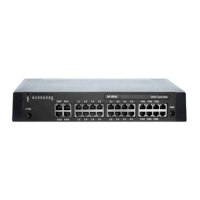55
E
XPANSION WITH CARDS AND MODULES
CHAPTER 3 EXPANSION STAGES AND SYSTEM CAPACITY
Call charge modules
Interface cards
Interface cards can be assigned to two categories:
• Trunk cards
These cards provide interfaces for connection to public dial-up networks or for networking systems
to create a private telephony network.
• Terminal cards
These cards provide interfaces for connecting digital and analogue voice and data terminals.
On some cards some of the interfaces are configurable (BRI-S/T). This means that these cards cannot
be clearly assigned to any particular category. They are listed both among the trunk cards and the
terminal cards.
Interface cards are fitted into slots IC1...IC4 (see Mainboard interfaces, display and control elements and
front panel).
The interfaces are routed to the front panel using the wiring adapters (see Wiring adapter
).
The length varies depending on the type of interface card. For precise dimensions see the Chapter Tech-
nical data.
Figure 3.4: Design of the interface cards
Trunk cards
The trunk cards contain interfaces for connection to the analogue public network (PSTN), the digital public
network (ISDN) or for networking systems to create a private telephony network (PISN). The trunk cards
can be used and operated on any slots for interface cards.
Some trunk cards contain both network interfaces (BRI-T) and terminal interfaces (BRI-S). On these
cards the ratio of BRI-S interfaces to BRI-T interfaces is determined by the use and plug-in orientation of
the wiring adapters (see Fitting a wiring adapter
).
Table 3.12:Trunk cards (Sheet 1 of 2)
Type Network interfaces
per card
Max. number
of cards
Remarks

